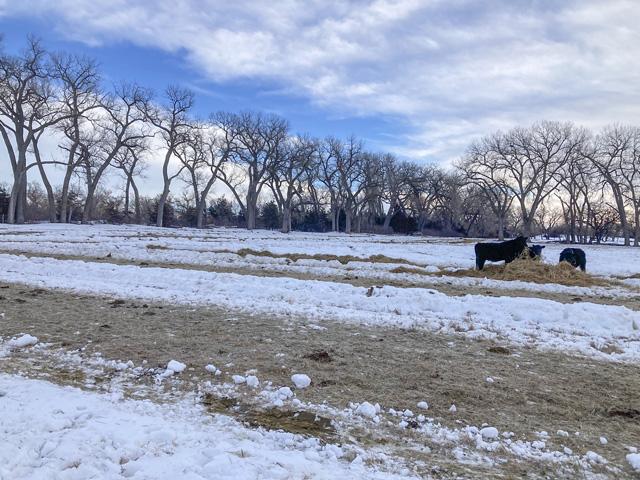Trees, Bales Work in Windbreaks
Be Strategic With Trees and Bales as Windbreaks to Protect Cattle From Challenging Weather
OMAHA (DTN) -- Frank Beel's family has operated the Beel Ranch near Johnstown, Nebraska, for generations. During that time, the family invested in planting trees to function as a shelterbelt (windbreak) for their cattle.
The ranch, located in Brown County in northern Nebraska, has several shelterbelts comprised of different species of trees. Frank's father started planting shelterbelts in the 1970s by transplanting volunteer trees, mainly cedar trees, to locations where it would benefit livestock.
Through the years, the Beels added a variety of trees in the shelterbelts instead of just cedar trees. Most of the natural windbreaks now consist of cedar trees, but the Beels also have cottonwood trees. This assortment of trees will maintain the windbreak even if a disease would come in and kill a certain type of tree.
"We continue to work with the Natural Resources District (NRD) to continue to plant trees," Beel told DTN.
This winter's weather in the Midwest helped show the value of those trees on their land.
"I couldn't imagine feeding cattle the last four weeks without the protection of the shelterbelts we have," he told DTN.
VARIOUS WINDBREAKS
There are different alternatives available to livestock producers who would like to use windbreaks to protect animals from low temperatures and snow like Beel faced. Options include manmade structures, planting trees and even temporary windbreaks built with cornstalk bales.
Trees planted strategically and cornstalks bales lined up to block the wintery winds can help livestock thrive even on the coldest days. Both windbreak designs can be effective to keep the wind and cold off livestock.
P[L1] D[0x0] M[300x250] OOP[F] ADUNIT[] T[]
Trees are nature's living windbreak. For generations, livestock producers planted trees to protect animals from high and low temperatures. Trees also provide a natural wildlife habitat.
STRATEGIC POSITION OF TREES
The majority of Beel's windbreaks are made up of six to eight rows of trees and 100 to 200 feet in length, he explained. They are situated so they grow southwest to the northeast to break the majority of the north winds.
Beel said some of the windbreaks sit next to roads or existing fence lines. A disadvantage would be those windbreaks only protect if the wind is from a certain direction, he said.
Beel's operation does have a few windbreaks planted in the middle of a pasture or hay meadow which helps protect the livestock no matter the wind direction.
USE CORNSTALK BALES
Corn Belt cattle producers often have access to cornstalks, which can be baled and serves as feed, bedding and more.
Erika Lundy-Woolfolk, Iowa State University Extension beef specialist for southwestern Iowa, said many cattle producers also use cornstalk bales as a temporary windbreak when they need to store the bales.
This option is a cheaper alternative than purchasing or building a metal or wooden permanent/mobile windbreak. Also, she explained producers will not have to worry about removing the temporary bale windbreak during the hot summer; the bales are no longer there to block winds that help lower heat stress in cattle.
Lundy-Woolfolk said the effective way to stack bales for a windbreak is to have a bottom row of bales stacked vertically (face to the ground) with the top row of bales stacked horizontally (face parallel to the ground). This is sometimes referred to as a "mushroom stack" design.
ADVANTAGES VS. DISADVANTAGES
There are some advantages and disadvantages to using cornstalk bales for windbreaks.
The first advantage is it's inexpensive. The cost of putting up these bales or buying cornstalk bales is low compared to purchasing metal or wood to build a windbreak.
A major disadvantage of using cornstalk bales as a windbreak is it lowers the quality of the bales because of the way they are positioned to create a windbreak.
"With this storage method, all the moisture that comes in contact with the top of the bale runs off directly into the face of the bottom bale," Lundy-Woolfolk noted. "Adding moisture directly into the bale -- whether it's cornstalks or hay -- rapidly declines the quality of that bale on the bottom of the stack."
If the intent of the cornstalk bales is to be fed, the feed value of the bales would decrease as winter progresses. If the intent is to use the bales for bedding, then this is less of an issue as moldy bales for bedding still have less absorption, she said.
See more on windbreaks, including tips on how and why to construct various other windbreaks, at " Different Windbreaks Designs Protect Livestock, Lower Feed Costs," https://www.dtnpf.com/….
Russ Quinn can be reached at Russ.Quinn@dtn.com
Follow him on Twitter @RussQuinnDTN
(c) Copyright 2023 DTN, LLC. All rights reserved.






